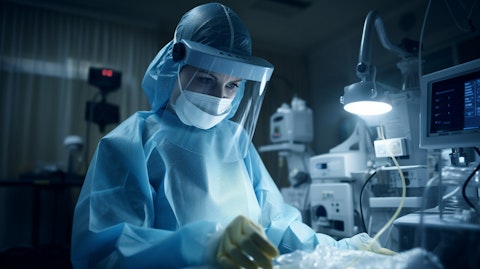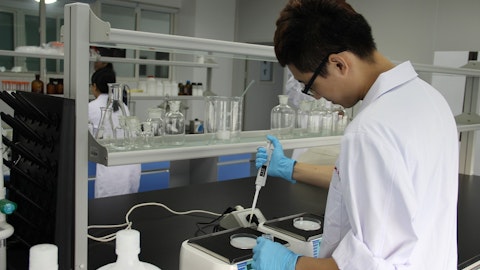STERIS plc (NYSE:STE) Q4 2025 Earnings Call Transcript May 15, 2025
Operator: Good morning, everyone, and welcome to the STERIS plc Fourth Quarter 2025 Conference Call. All participants will be in a listen-only mode. [Operator Instructions] After today’s presentation, there will be an opportunity to ask questions. [Operator Instructions] Please also note, today’s event is being recorded. At this time, I’d like to turn the floor over to Julie Winter, Investor Relations. Ma’am, please go ahead.
Julie Winter: Thank you, Jamie, and good morning, everyone. As usual, speaking on today’s call will be Mike Tokich, our Senior Vice President and CFO; and Dan Carestio, our President and CEO. And I do have a few words of caution before we open for comments. This webcast contains time-sensitive information that is accurate only as of today. Any redistribution, retransmission or rebroadcast of this call without the expressed written consent of STERIS is strictly prohibited. Some of the statements made during this review are or may be considered forward-looking statements. Many important factors could cause actual results to differ materially from those in the forward-looking statements, including, without limitation, those risk factors described in STERIS’ securities filings.
The Company does not undertake to update or revise any forward-looking statements as a result of new information or future events or developments. STERIS’ SEC filings are available through the Company and on our website. In addition, on today’s call, non-GAAP financial measures, including adjusted earnings per diluted share, adjusted operating income, constant currency organic revenue growth and free cash flow will be used. Additional information regarding these measures, including definitions is available in our release as well as reconciliations between GAAP and non-GAAP financial measures. Non-GAAP financial measures are presented during this call with the intent of providing greater transparency to supplemental financial information used by management and the Board of Directors in their financial analysis and operational decision-making.
With those cautions, I will hand the call over to Mike.
Mike Tokich: Thank you, Julie, and good morning, everyone. It is once again my pleasure to be with you this morning to review the highlights of our fourth quarter performance from continuing operations. For the fourth quarter, total as reported revenue grew 4%, constant currency organic revenue grew 6% in the quarter, driven by volume as well as 210 basis points of price. Gross margin for the quarter increased 170 basis points compared with the prior year to 44.3%. Positive price, favorable mix and productivity outpaced labor inflation. EBIT margin increased 110 basis points to 24.8% of revenue compared with last year. The adjusted effective tax rate in the quarter was 23.5%. The year-over-year increase was driven by unfavorable discrete item adjustments.
Net income from continuing operations in the quarter was $270 million, adjusted earnings per diluted share from continuing operations was $2.74, a 40% increase over the prior year. We are pleased with our ability to grow earnings double digits all year with lower interest expense following the divestiture of the Dental segment. Capital expenditures for fiscal 2025 totaled $370 million, while depreciation and amortization totaled $476 million. We continue to pay down debt during the quarter, ending with $2 billion in total debt. Gross debt to EBITDA at quarter end was approximately 1.4x. Free cash flow for fiscal 2025 was a record $787 million, well above our full year guidance, driven by significant working capital improvements, in particular, inventory.
With that, I’ll turn the call over to Dan for his remarks.

Dan Carestio: Thanks, Mike, and good morning, everyone. Thank you for joining us to hear more about our fiscal 2025 performance and our outlook for fiscal 2026. Mike covered the quarter, so I will touch on our performance for the full year and our outlook for fiscal 2026. From a total company perspective, we ended the year with 6% revenue growth and 12% earnings growth. The diversified nature of our business allowed us to deliver results in line with our original outlook despite a few obstacles during the year. Looking at our segments, Healthcare constant currency organic revenue grew 6% for the year, led by strong recurring revenue streams. Our outperformance in consumables and services continues to be driven by procedure volumes in the U.S. as well as price and market share gains.
Healthcare capital equipment revenue declined 5% for the year against our record year last year. Capital equipment orders grew over 12% for the full year as underlying demand remained strong. Margins improved nicely in Healthcare, hitting the 25% mark for the year, with volume, pricing and positive productivity offsetting labor inflation. Towards the end of the year, we also began to benefit from the restructuring cost savings, capturing approximately $5 million in savings in the fourth quarter of fiscal 2025. Turning to AST. Constant currency organic revenue grew 9% for the year with 7% growth in services. Med device customers remained stable, while bioprocessing was a bit lumpy during the year. Capital equipment shipments more than doubled compared to the prior year and exceeded our expectations.
EBIT margins for AST were 44.8%, down slightly year-over-year as we continue to face energy and labor headwinds and had a negative mix shift from capital equipment shipments. Constant currency organic revenue increased 1% for Life Sciences for the full year, driven once again by strong growth in consumables and services, offset by a decline in capital equipment revenue. Margins increased to 42.3%, a 360 basis point improvement, benefiting from favorable mix, pricing and the divestiture of the CECS business. From an earnings perspective, we ended the year strong and exceeded our revised outlook with adjusted EPS of $9.22. The upside to our estimates was driven by lower corporate spending and improved profitability in both Healthcare and the Life Science segments.
Turning to our outlook for fiscal 2026. As noted in the press release, we anticipate as reported revenue from continuing operations to grow 6% to 7% in fiscal 2026. We do not have any acquisition or divestiture impacts heading into the new fiscal year, and changes in foreign currency are expected to be neutral to STERIS. As a result, constant currency organic revenue growth is also expected to grow 6% to 7%. Included in this outlook is approximately 200 basis points of price. Each segment is expected to grow revenue in the range of 6% to 7% for fiscal 2026. One minor note on AST revenue growth, our outlook reflects high single-digit growth in services revenue, which will be somewhat offset by a decline in capital equipment to get to the 6% to 7% growth total for the year.
As you saw in the press release, we have estimated the impact for tariffs for fiscal 2026, which are reflected in our outlook. We manufacture a significant number of products in North America for use in the U.S., with about 85% of the products sold in the U.S. coming from North American manufacturing. This significantly reduces our tariff exposure compared to many others, but we are not immune to the impact of tariffs. Our fiscal 2026 outlook of $9.90 to $10.15 includes $30 million of tariff costs. The EPS range implies 7% to 10% growth in earnings, including tariffs, which is impressive performance. I want to take a moment to thank our supply chain and commercial teams for all their efforts on this front. The anticipated tariff impact is a net number.
We do expect to leverage the strength of STERIS to mitigate some of our exposure. The $30 million estimate is based on global tariffs currently in effect, including the 10% global tariff and the recently announced 90-day trade deal with China. For your modeling purposes, at the high end of our earnings range, we would expect EBIT margins to increase approximately 20 basis points, reflecting our ability to offset tariffs. The effective tax rate is planned at approximately 23.5%. As we enter into the new fiscal year, we are well positioned to deliver both top and bottom line growth in 2026. That concludes our prepared remarks for the call. Julie, would you please give the instructions so that we can begin the Q&A.
Julie Winter: Thank you, Mike and Dan, for your comments. Jamie, can you please give the instructions for Q&A and we’ll get started.
Q&A Session
Follow Steris Corp (NYSE:STE)
Follow Steris Corp (NYSE:STE)
Receive real-time insider trading and news alerts
Operator: Ladies and gentlemen, at this time, we’ll begin the question-and-answer session. [Operator Instructions] And our first question today comes from Dave Turkaly from Citizens.
Dave Turkaly: Congrats on the quarter and the year. I guess, when we look at the segments, the biggest implied delta is then at LifeSci. And I was just curious to get some color on your comfort in that kind of bouncing back to that 6% to 7% range.
Dan Carestio: Yes. We did extremely well this year in our recurring revenues, especially our chemistries and consumables business and we would expect that to continue. Where we were down significantly was obviously capital equipment with a lot of uncertainty in pharma, the orders just dried up in the first half of the year. However, we saw a really strong rebound late in the year, and we are coming into fiscal 2026 with a pretty good backlog at a pretty good rate of orders. So we’re confident that we’ll be able to deliver the bulk of those in the fiscal 2026 and continue on with the growth that we’ve seen historically within our consumables business.
Dave Turkaly: Great. One quick follow-up. It seems like the tariff impact might be, I don’t know, $0.24 or something like that on the EPS line, yet you’re still getting into double-digit range at the high end. I guess if you could just talk about some of the puts and takes, maybe even on the interest expense. I know you delevered a bunch, but to get to that even despite the tariffs, just maybe some color there.
Mike Tokich: Yes, Dave, this is Mike. So as normal, there’s quite a bit of headwinds or tailwinds or puts and takes. First and foremost, we are going to benefit from about $20 million of restructuring cost savings that will be in FY ’26. So that’s a good guide. In addition to that, we do not anticipate spending $20-plus million in ETO litigation. We anticipate spending about $5 million. So there’s $15 million to the good also. But offsetting that is incentive comp getting back to 100% bonus. That is a negative $15 million. Obviously, the tariffs are another negative $15 million. And then if you look at our lower interest expense is really going to offset our higher tax rate. So that’s just a reconciliation for FY ’26 or the puts and takes.
Operator: Our next question comes from Mike Matson from Needham & Company.
Mike Matson: Yes. So just your cash flow guidance is a little bit down from ’25. I know you called out the working capital improvement you saw in ’25. I mean is that the main kind of differential between the two years?
Mike Tokich: The big thing, Mike, is we anticipate paying $40 million legal settlement for ETO, which is in FY ’26. So that’s going to negatively impact cash by $40 million. And of course, we are not anticipating to overachieve or reduce inventory as dramatically as we had in FY ’25. But the big difference is the ETO legal fees, plus the impact of tariffs will negatively impact free cash flow also.
Mike Matson: Okay. Got it. And then just your leverage ratio is down quite a bit. So just maybe you can give us an update on M&A. I’d expected you’d probably be looking to do some more deals if you can find things, but…
Dan Carestio: Yes. I mean — this is Dan. What I would say, Mike, is that we have the capacity both from a financial perspective and from an intellectual perspective at this point, having not done any meaningful M&A now for a few years. So if the right opportunity presents itself, we’ll be involved.
Operator: Our next question comes from Patrick Wood from Morgan Stanley.
Patrick Wood: Just two quick ones. It’s probably too early to say, but how the conversations with the customer has been around potentially like onshoring back to the U.S.? I’m trying to think of — I know some of the outsourced contract manufacturers have seen like a big pickup in people trying to pull production back. I’m just curious, is that something that you think is actually going to happen or is it more just a nice bullet point on a McKinsey slide.
Dan Carestio: It’s probably the latter. But I do think there is some opportunities. I assume you’re talking about med tech in particular, but I do think there are some opportunities. Many of those large companies have manufacturing for local regions. And to the extent that they may be manufacturing in Europe for the U.S. and they have U.S.-based manufacturing for similar products, you may see some shift of volumes going east or west depending on the benefit that they can do in terms of tariff and how easy it is to do it. Keep in mind, highly regulated industry, it’s not easy to move production volumes if they don’t have all the regulatory permits and things like that. So it takes time. But there’ll be some fluidity to it, I’m sure.
Patrick Wood: That’s awesome. And then just like quickly around the — kind of that M&A angle again. What have you been hearing from some of the smaller players, niche out compliance costs, all those sorts of things? Is there a situation where — I know EO capacity is tight, but is there a situation where they end up having to force sell themselves essentially to you guys or your peers? Like how do you think about industry consolidation on the back of the kind of one-off costs there?
Dan Carestio: I mean, in a general sense, I do think there’ll be some industry consolidation, but we’d be in a much better position, greenfielding than we would be buying assets that are 30-plus years old.
Patrick Wood: I mean I’m 40, so I take offense of that.
Dan Carestio: Well, you’ve been compliant your whole life.
Patrick Wood: That’s definitely not true.
Operator: Our next question comes from Mac Etoch from Stephens, Inc.
Mac Etoch: I’ll add my congrats on the quarter and the year as well. Maybe just touching on the outlook for FY ’26. As you commented on AST kind of coming in line with the 6% to 7% growth for the year, low single digits for capital equipment, high single digits for services. But can you flesh out what you’re seeing within the respective customer bases there? I think there’s a little bit of a delta between what maybe I and the Street were expecting versus your internal expectations. So if you could just provide us a little color there, that would be great.
Dan Carestio: Yes. I think what we’re doing here is we’ve seen a lot of just movement month-to-month, quarter-to-quarter in terms of volume. It has started to sort of modulate down. But our view is let’s take a little more conservative approach on how aggressively some of the bioprocessing is going to recover and also as customers reassess where they’re manufacturing and if there is any movement going on and what implications that may have on total volume.
Mac Etoch: Got it. And then just in light of like the current macro and everything that’s going on with general policy, is there — how are conversations progressing with clients? Has there been any change in behaviors relating to Life Sciences or the AST segment?
Dan Carestio: Nothing that I would point to. There’s a number of discussions, but I can’t say there’s anything concrete.
Operator: Our next question comes from Michael Polark from Wolfe Research.
Michael Polark: Maybe two on Healthcare. The first one, the allusion to market share gains driving growth in the fiscal year and quarter. I know we’ve talked about this before, but is there any service or business line that really stands out to you there as to STERIS doing way better than market? If so, what is it? And what’s going right?
Dan Carestio: Honestly, I would say it’s just across the entire segment right now. Our teams are just doing a phenomenal job, in particular, in the North American markets that we’re just — we’ve just built out such a great portfolio and enterprise solution for large systems around sterile processing in particular and all the services that go along with that, that we continue to do really well.
Michael Polark: And for the fiscal year ahead, 6% to 7% growth for the Healthcare segment, would you call out any expected variances between how consumables, services and equipment should grow in ’26?
Dan Carestio: No, we’re not going to provide that level of granularity. I will hit back on the fact that we had a great order year for — that bodes well in terms of backlog for capital going into next year. And — so we’re optimistic about that.
Operator: Our next question comes from Jason Bednar from Piper Sandler.
Jason Bednar: Nice finish to the year here. I wanted to see if we could spend just maybe a bit more time on tariffs, really topical for all companies here this quarter. Maybe break down, if you could, what the — what that $30 million looks like across your network? I think — I know you had $30 million in the press release. Mike, I think you made some comment at one point, I think, early on around $15 million, but just want to confirm it’s $30 million net. And then if possible, break down, maybe again how much exposure you have here around like China-related tariffs and how much on the non-China side? It would just be helpful so we can update our own thinking as we see the next updates on the tariff front.
Dan Carestio: I mean — this is Dan. I’ll let Mike add to this. But at a high level, it’s about half China and half sort of the 10% global tariff, and it’s about $30 million.
Mike Tokich: No more to add on that.
Jason Bednar: All right. I like it. I think you said that $30 million, again, is a net number. Are you assuming any mitigation actions in that $30 million figure? Kind of what does that — the pacing of that activity look like throughout fiscal ’26? And then I’ll just sneak in one extra here. It looks like share repo was a little lighter in the fourth quarter compared to the prior few quarters, but the stock has been hanging around a similar level now for some time, well off its size. Maybe just talk about the decision to pause some of that activity? And is there a signal we should draw from that pause?
Mike Tokich: Yes. I would say that, in general, we had bought about $200 million of shares during FY ’25. We had bought those earlier in the year compared to the previous year. And I would say there’s no signal that we’re driving there. It is almost double what we typically bought just to offset dilution. And obviously, with our debt levels and debt ratios being where they are, we would definitely consider doing additional share buybacks beyond our offsetting — just offsetting dilution in the future.
Jason Bednar: Sorry, on the mitigation activity on tariffs?
Mike Tokich: Yes. The $30 million is a net number, Jason. So it’s significantly higher than that. Obviously, there’s a lot to be done to mitigate. Timing is always the question. Obviously, our supply chain guys and girls are working very hard to offset as much as possible. But yes, it’s a net number of $30 million, and we anticipate that, that will hit us about equally throughout the calendar year.
Dan Carestio: Yes. I would just add to that. With the 90-day pause or sort of redirect on the China tariffs, it gives us an opportunity to be much more strategic and thoughtful in terms of anything that we’re changing as it relates to either vendors or manufacturing location or supply. So I would expect more weight on the back end.
Julie Winter: And also, I don’t think we’ve said there’s more weight on health care that primarily will be impacting the Healthcare segment with a little bit in Life Sciences.
Mike Tokich: And very, very little, if any, in AST.
Operator: [Operator Instructions] Our next question comes from Brett Fishbin from KeyBanc.
Brett Fishbin: Just wanted to ask another question on Healthcare capital equipment. It sounds like you’re not trying to give specific guidance on growth, but maybe just talk a little bit more about the capital equipment backdrop. You’re exiting the year with some growth in the backlog, but really just curious how like some of the recent macro developments have impacted like either ordering patterns or like hospitals’ willingness to do implementations versus like any deferrals you may be seeing?
Dan Carestio: We’ve talked about this a lot in the past, and that is the capital equipment that we offer is really more of a utility than a luxury item. If you’re going to see procedural growth and migration of procedures in different places, you can’t accommodate that growth without having sterile processing capacity or surgical suites. So at times when it may impact replacement business, if those things can be deferred, it doesn’t really impact the new equipment in terms of going into expansions. So we had a great order year last year, growing orders 12%. We’ve got our backlog into a very comfortable position. We haven’t seen anything at this point that would indicate that, that’s slowing for us and in fact, had really good volume in terms of orders going into Q1. So we’re excited about the opportunity there.
Brett Fishbin: And then just as a follow-up, I’m going to switch gears a little bit to AST. I think it was a pretty good sequential progression in FY ’25 from an AST growth standpoint. Just looking at FY ’26, for services, it sounds like high single digits is kind of the starting point. I’m just curious if like demand were to be higher than expected, do you have enough capacity to theoretically return to double-digit growth in AST service? Or is capacity starting to become like a little bit of a limiting factor?
Dan Carestio: Sure. It’s not a governor for us right now. We are well positioned to accommodate the industry’s growth.
Operator: And our next question is a follow-up from Michael Polark from Wolfe Research.
Michael Polark: Just one more also on AST. As you reflect on fiscal ’25 in the services line, the December quarter was up 10%, March quarter up 6%. Dan, it sounds like bioprocess is a little lumpy. Is that the gyration or anything else to kind of spike out on the phasing of the last 12 months that makes more sense to you? My one other idea is any evidence that there was kind of front-loading of inventory building ahead of the Trump tariff era in the December quarter? Could that have been an influence in that period? Any other color would be great.
Dan Carestio: Sure. Yes. No, we did not see that in terms of anybody front-loading tariff, but I think you’re giving the industry way too much credit to be able to see that coming. What I would say is we had a phenomenal December, an extraordinary December in terms of year-over-year comps. And then nobody showed up for the first seven days of January. So just the plant restarts from a customer perspective was very abnormally slow this year, one day shorter of February in terms of processing days, and then we had a wonderful second half of February and March in terms of growth. So — but overall, those things impacted the quarter. I don’t think it was anything more than that.
Operator: And ladies and gentlemen, with that, we’ll conclude today’s question-and-answer session. I’d like to turn the floor back over to management for any closing remarks.
Julie Winter: Thank you, everybody, for taking the time to join us this morning. We look forward to catching up with many of you in the coming weeks.
Operator: And with that, ladies and gentlemen, we’ll conclude today’s conference call and presentation. We do thank you for joining. You may now disconnect your lines.
Follow Steris Corp (NYSE:STE)
Follow Steris Corp (NYSE:STE)
Receive real-time insider trading and news alerts





